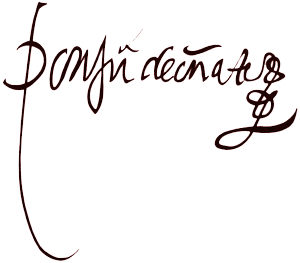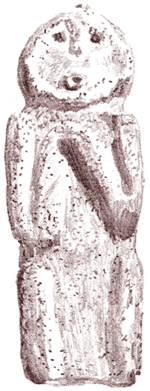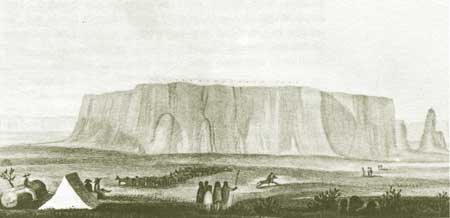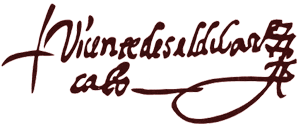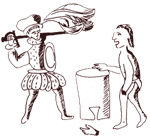

Contents Foreword Preface The Invaders 1540-1542 The New Mexico: Preliminaries to Conquest 1542-1595 Oñate's Disenchantment 1595-1617 The "Christianization" of Pecos 1617-1659 The Shadow of the Inquisition 1659-1680 Their Own Worst Enemies 1680-1704 Pecos and the Friars 1704-1794 Pecos, the Plains, and the Provincias Internas 1704-1794 Toward Extinction 1794-1840 Epilogue Abbreviations Notes Bibliography |
The Adelantado at Pecos For weeks the Pecos knew they were coming. But not until July 25—feast day of Santiago, as the invaders reckoned it—did the latest army of Spaniards draw up before the impressive eastern pueblo. Leaving his cumbrous wagon train behind, Juan de Oñate had ridden ahead with some sixty armed and mounted men to receive the homage of his Pueblo subjects. He had encountered no resistance among Piros, Southern Tiwas, Keres, Northern Tiwas, and Tanos. Now he beheld "the great pueblo of Pecos," subdued eight years earlier by Gaspar Castaño de Sosa only after a fierce battle. "This is the province Espejo called Tamos, from which came a certain don Pedro Oroz, an Indian of this land who died at Tanepantla under the care and instruction of the Franciscan Fathers." [13] Standing nearby in his abbreviated Franciscan habit was the Mexican Indian donado Juan de Dios. He had learned the language of this pueblo from the abducted Pedro Oroz. He interpreted for the governor and the two friars present, Comisario Alonso Martínez and Fray Cristóbal de Salazar, a cousin of don Juan. Two of Oñate's men, likely on hand this day, had fought in the battle of 1590—the medium-built, brown-bearded Ensign Juan de Victoria Carvajal and graying Juan Rodríguez, a Portuguese who would soon desert the New Mexico colony "at full gallop." A couple of weeks earlier at the Keres pueblo of Santo Domingo, where he had received in a large kiva the submission and vassalage of several native leaders, don Juan apprehended two of Castaño's Indians, Tomas and Cristóbal. They had been there since 1591 and spoke Keresan. They too stood with the Spaniards before Pecos. Even though he had Juan de Dios, interpreter in the language of this pueblo that called itself Cicuye, Oñate consistently used the Keresan name Pecos, as did the soldiers and Indians of Castaño, and everyone who came after them. This day the Pecos chose not to fight. Apparently they permitted the Spaniards the usual ritual acts—the harangues and planting of the cross and volleys. In honor of the day, the friars assigned Santiago as patron saint of the Pecos. The governor and his party left the next day. Six weeks later, after the Spanish colony had settled in at San Juan pueblo among the Tewas, the "captains" of Pecos were summoned to present themselves there, along with principales from other pueblos who had not yet rendered obedience. Most likely Juan de Dios delivered the message. Whoever did, the Pecos responded. Like Coronado, the bold Oñate had appropriated an entire native pueblo as his headquarters. Its name sounded to the Spaniards like Ohke. They had christened it San Juan Bautista. Here Oñate had set colonists and Indians to work building the first church in New Mexico, "large enough to accomodate all the people of the camp." By September 7, it was far enough along to dedicate. The following day, Tuesday, feast of the Nativity of the Blessed Virgin, the Spaniards crowded inside for solemn high Mass with all ten friars assisting. Father Commissary Martínez consecrated altar and chalices. Fray Cristóbal de Salazar delivered the sermon.
Oñate's Grant to the Friars When the Last Gospel had been sung, Oñate's secretary Juan Pérez de Donís, a man of medium build with gray beard and an old scar across his forehead, stepped to the front to read a proclamation from the governor. "In loud and intelligible voice" he began in the name of "don Juan de Oñate, governor, captain general, and adelantado of the kingdoms and provinces of New Mexico and those adjacent and bordering, their pacifier and colonizer for the king our lord, etc." Having been in this land since May and having personally pacified more than one hundred leagues of it, the governor deemed that the time had come to realize the expedition's highest purpose—"the conversion of the souls of these Indians, the exaltation of the Holy Catholic Church, and the preaching of the Holy Gospel." He had therefore summoned the native captains and principal men "with an Indian messenger and a small book of mine as a memento," and they had come.
Juan Pérez de Donís caught his breath. He had reached the critical point—Oñate's concession of New Mexico to the Franciscans.
The secretary then intoned the list of provinces and pueblos, stretching from the Piros in the south to Taos in the north and from the Hopis in the west to "the province of the Pecos situated to the east of us, with the Querecho and Serrano Indians of its district," The proclamation concluded with an assurance to the friars that the king would sustain them with his royal alms in temporal matters while "they sustain their pueblos in spiritual matters." Father Commissary Martínez accepted for himself, his brethren present, and all sons of St. Francis. In order that Oñate's laudable act might be of lasting record, the Franciscan superior requested a copy of the concession. When he had signed with the governor's principal officers, the formalities concluded. Don Juan de Oñate, broadly interpreting his instructions and his authority, had installed the friars "for all time." [14]
After they had consecrated their church and provided for the conversion of heathen souls, the Spaniards gave themselves over to "great celebrations," singing, dancing, jousting, gaming, and the like. As a climax, they treated the assembled Pueblo leaders to a thoroughly Iberian ceremonial, "a good sham battle between Moors and Christians, the latter on foot with arquebuses, the former on horseback with lances and shields." [15] The Pueblos Render Homage The next day, September 9, 1598, the governor bid the native leaders "of the Tiwas, Puaray, Keres, Zias, Tewas, Pecos, Picuris, and Taos" join him in the main kiva. There in the presence of his officers, the friars, and his secretary, don Juan explained "the purpose of his coming and what was best for them." He spoke through at last four interpreters, including "the beloved brother Juan de Dios, Franciscan donado, interpreter of the language of the Pecos." He used words suggested by the ordinances of 1573 and his instructions from the viceroy,
Then, in the close atmosphere of the kiva, he gave them a lesson in elementary theology: one God, creator of the universe and judge of all men; good and evil; heaven and hell; God's servants on earth, the Roman pontiff and the Spanish king. He admonished them to obey and respect the representatives of pope and king. When the seated Pueblo principales "understood the meaning of this explanation, they replied through their interpreters that they of their own free will desired to render . . . obedience and vassalage to God and king." As a sign of their commitment Oñate instructed each of them in turn to rise, approach Father Commissary Martínez and him, kneel, and kiss their hands. It would be very much to their advantage, the adelantado continued, if they would take the Franciscans to their pueblos so that these men of God could learn their languages, instruct them in the Christian faith, baptize them, and thereby save their souls from the fires of hell. The Indians agreed. Before dismissing them, the Spaniards cautioned that they must treat the padres well, support them, and obey them in everything. He repeated this three times. If they failed to heed their friars or harmed them in any way, "they and their cities and towns would be put to the sword or burned alive." They said they understood. Missionaries Assigned Next Oñate and the Father Commissary, who had agreed beforehand, assigned the missionaries.
After all the priests and pueblos had been matched, the Indian principales in attendance were told to kiss the hand of the friar assigned to them "and to take charge of him." That concluded the rite. A week later Sargento mayor Vicente de Zaldívar led a well-mounted and well-supplied Spanish column, some sixty strong, out of San Juan bound for the buffalo plains. Fray Francisco de San Miguel and donado Juan de Dios accompanied them as far as the teeming pueblo of Pecos, which they reached September 18, 1598. After two days, the expedition moved out, leaving the aged friar and his assistant to begin their ministry to the Pecos people. It lasted not three months. [17] The Ministry of Francisco de San Miquel Fray Francisco was old in years and poor in worldly goods, full of his God the Father, God the Son, Holy Poverty, and a Blessed Mother, none of which necessarily offended the Pecos. This elderly Franciscan already knew some words in their language, words he had learned from Juan de Dios. He wanted to know more. Three years later, when he was "seventy years old more or less," Fray Francisco testified that he had begun learning four native languages, "that he had worked very hard at it, and that he had labored with the Indians and native people to convert them and bring them to the holy gospel." But he admitted to "very great difficulty" in his ministry because other Spaniards abused the Pueblos. [18]
Despite his advanced age, Francisco de San Miguel had not been a friar as long as he might have been. Evidently he had entered the Order in 1570 relatively late in life, at the age of forty or so. After the year-long novitiate, he professed his religious vows on April 18, 1571, at the Holy Gospel province's convento in Puebla. A cumulative provincial roster compiled in the eighteenth century provided no further information about him, not even his place of birth. A decade after his profession—about the time of the Sánchez Chamuscado and Espejo entradas—Fray Francisco had set out for the frontier. Unfortunately he was not a theologian, an administrator, or a martyr, so the chroniclers ignored him. Only as a participant in the Oñate enterprise did he emerge again. [19] Father San Miguel's apostolic labors at Pecos are as shadowy as the rest of his life. There is no record of his acceptance or rejection by the people: how many baptisms of Pecos Indians in danger of dying, if any, he performed; how many of his assigned Tiwas, Tompiros, Jumanos, Apaches, and others, if any, he visited. It is not known whether at this early stage Fray Francisco chose to confront the "idols" in Pecos kivas, as did a successor twenty years later. The First Church at Pecos There is only one tangible clue to San Miguel's ministry, and even it is questionable. On a narrow, piñon-studded ridge, a thousand feet more north than east of the main Pecos pueblo, archaeologists uncovered the ruins of a simple, rectangular adobe church built, in their opinion, "not later than in the first two decades of the 1600's." Near the trail the Pecos used going and coming from their fields along the river, the site afforded a dramatic vista of tiered pueblo set against massive, reddish cliffs of the mesa beyond. The church faced south, more or less in the direction of the pueblo, rested on a rather narrow but well-laid stone foundation, and measured inside roughly twenty-five by eighty feet. It had been roofed and mud-plastered inside and out. An unfinished sacristy, containing some two hundred and fifty stacked adobes, clung to the east wall. Because the level area was barely wide enough for the church alone, and the bedrock near the surface, the builder cannot have planned to adjoin either convento or cemetery. Just north of the church, however, where the ridge broadens out, he could have built either. If ever the structure was used, it must have been only briefly. The excavators found no trace of European artifacts. [20] The distance of church from pueblo may be evidence of Pecos resistance. If in fact Father San Miguel and donado Juan de Dios were supervising construction of this first Pecos church during the fall of 1598, they left in a hurry. Early in December, chilling news reached them. When he had received the vassalage of Pueblo leaders and distributed the Franciscans among them, don Juan de Oñate had set about exploring his huge domain in earnest. He had dispatched Vicente de Zaldívar to the buffalo plains to report all he saw, to contact the natives, and to find out if the "cows" could be domesticated. Oñate himself had ridden out in October to assess the value of the salines east of the Manzano Mountains and to receive homage from nearby pueblos. From there he headed westward for the sea. At the pueblos of Ácoma, Zuñi, and Hopi, he and his men had been received without incident and given water, maize, and turkeys. He had sent a captain to verify the Zuñi salt lake and some silver deposits the Hopis had described. Then in mid-November, he turned back to the Zuñi pueblos to await the appearance of his elder nephew Maese de campo Juan de Zaldívar with reinforcements for the trek to the South Sea.
Zaldívar Murdered Zaldívar never made it. He and his column had stopped at Ácoma to exact provisions. Invited up onto the penol with a small party on December 4, the maese de campo had walked into a trap. He and a dozen of his men, fighting savagely hand-to-hand in the sudden onslaught, went down under swarms of Ácoma warriors. A few Spaniards escaped. Within days Oñate knew. As word spread, the governor led his men back to San Juan. The missionaries and their helpers hastened in from their posts on orders from Father Commissary Martínez. Father San Miguel and Juan de Dios abandoned Pecos. Evidently the people razed the church and used some of the beams and adobes to construct a kiva. No missionary would live at Pecos for another twenty years. At San Juan, the hastily assembled colony prepared to meet the crisis. Oñate listened to survivors recount the tragedy. He established for the record two important facts: that the attack on Zaldívar's force had been deliberate, premeditated, and treacherous; and, that until the Spaniards laid waste the defiant fortress-pueblo of Ácoma, there could be no peace in the land. The governor next called upon Father Commissary Alonso Martínez for a definition of just war. The friar, dutifully citing scripture, church fathers, philosophers, and legalists, concluded, "Finally, if the cause of war is universal peace, or peace in his kingdom, he [i.e., the Christian prince] may justly wage war and destroy any obstacle in the way of peace until it is effectively achieved." The five Franciscan priests on hand, including Father San Miguel, affirmed their superior's "very Christian and learned" opinion. After Mass on January 10, 1599, the colonists resolved at a general meeting that Ácoma must be punished at once: any delay would see the entire kingdom in rebellion against the Spaniards.
The Harsh Punishment of Ácoma
Taking seventy soldiers—about half the colony's total force—the slain Zaldívar's younger brother Vicente set forth to humble the rebels of Ácoma. Incredibly enough, he did just that. In a bold and well-engineered two-day assault, he carried and sacked the "impregnable stronghold." According to Spanish sources, the Ácoma men, sensing defeat, began to kill one another and their families rather than surrender. The invaders took as many captives as they could, "upwards of five hundred men, women, and children." At populous Santo Domingo, an elated Oñate met the returning heroes and dealt with the Ácoma prisoners. All the Pueblos watched. They did not understand the formalities of the trial the Spaniards recorded so diligently, but they saw the brutal results. Ácoma males, twenty-five and older, the governor sentenced to have one foot hacked off. Like the young men and the women, these defeated and mutilated warriors must in addition serve twenty years as slaves of the invaders. Two Hopis caught at Ácoma were to lose their right hands and "be set free in order that they may convey to their land the news of this punishment." [21] | ||||||||||
 Top Top
|
| ||||||||||


